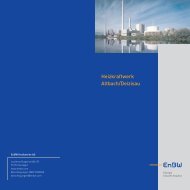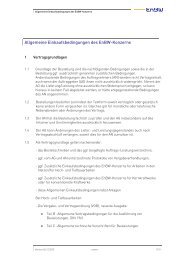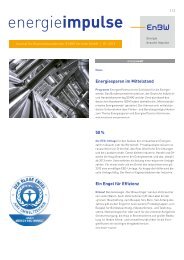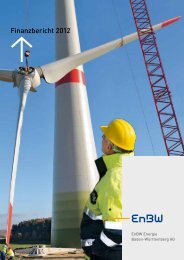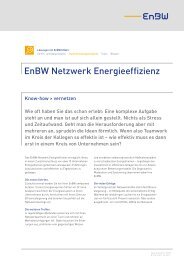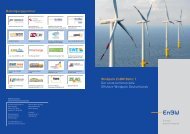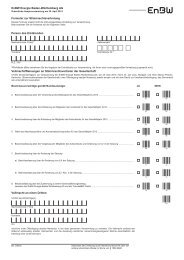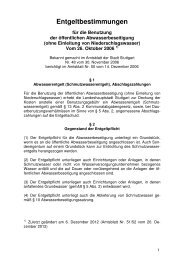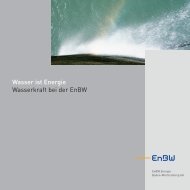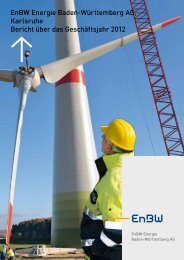2008 I 2009 Sustainability Report - Econsense
2008 I 2009 Sustainability Report - Econsense
2008 I 2009 Sustainability Report - Econsense
Create successful ePaper yourself
Turn your PDF publications into a flip-book with our unique Google optimized e-Paper software.
Glossary<br />
Biomass<br />
Biomass is the term used to describe all<br />
plant and animal matter as well as the products,<br />
residual substances and waste resulting<br />
from their use. This includes wood, cereals<br />
and vegetable oils as well as organic<br />
waste and residual matter from forestry<br />
(bark), agricultural (manure), industrial<br />
(grape pulp) and commercial (organic<br />
waste) operations.<br />
Carbon capture and storage (CCS)<br />
CCS is the abbreviation used to describe the<br />
technology for carbon dioxide capture and<br />
storage. Various different techniques are already<br />
undergoing small-scale trials. They<br />
should be available for technical application<br />
on a large scale by 2020 and allow low-CO 2<br />
utilisation of fossil fuels for the generation<br />
of electricity. No final decision has yet been<br />
made on transport systems or storage locations.<br />
According to the EU, however, all coalfired<br />
power plants must be CCS-ready by<br />
2020 – in other words, they must permit<br />
retrofitting of this technology.<br />
Clean Development Mechanism (CDM)<br />
CDM, the mechanism for environmentally<br />
compatible development, is one of the flexible<br />
instruments defined by the Kyoto Protocol.<br />
CDM projects are climate protection<br />
projects implemented in developing countries<br />
by industrialised states. These projects<br />
must be sustainable and must be implemented<br />
in addition to existing projects. The<br />
emissions avoided by the projects are reviewed<br />
and certified by independent institutions.<br />
Industrialised countries and companies<br />
can then claim credits for the CDM<br />
emission certificates to help them to meet<br />
their own emission targets.<br />
56<br />
Clean Diesel<br />
EnBW's clean diesel particulate filter system<br />
is an innovative, environmentally efficient,<br />
self-contained particulate reduction system.<br />
It is defined for retrofitting to utility vehicles,<br />
ships, rail vehicles and stationary diesel<br />
engines. Utility vehicles fitted with the<br />
clean diesel system qualify for Euro 4 classification<br />
and the German green environmental<br />
sticker.<br />
Compliance<br />
Comprises all organisational measures<br />
designed to ensure compliance with laws,<br />
regulations and internal guidelines as well<br />
as contractual obligations and voluntary<br />
commitments in the key areas and processes<br />
of corporate activity.<br />
CO 2 footprint<br />
The computed amount of carbon dioxide<br />
(CO 2 equivalents) emitted into the atmosphere<br />
as a result of the activities of a company<br />
or even an individual person.<br />
Cogeneration<br />
The waste heat from a power plant can be<br />
used to heat buildings in the vicinity or as<br />
process heat. This means more energy is<br />
obtained from the same fuel input. A power<br />
plant that generates both electricity and<br />
heat in this way is called a combined heatand-power<br />
plant.<br />
Corporate governance<br />
The totality of basic principles and rules<br />
geared towards the interests of shareholders<br />
and relating to organisation, conduct and<br />
transparency that are designed to ensure a<br />
balanced relationship between executive<br />
management and monitoring activities at<br />
the highest governance level of the company<br />
while ensuring decision-making<br />
capability and efficient leadership.<br />
"E-Energy" promotion programme<br />
A new core initiative launched by the German<br />
Ministry of Economic Affairs and Technology.<br />
Within the framework of this programme,<br />
EnBW was presented with an<br />
award in recognition of its "MeRegio –<br />
Minimum Emission Region" project. The<br />
aim of the project is to reduce greenhouse<br />
gas emissions in a model region.<br />
Emissions<br />
Emissions are the gaseous, liquid or solid<br />
substances released into the atmosphere or<br />
other parts of the environment from an installation<br />
or other technical process; they<br />
also take the form of noise, vibrations, radiation<br />
and heat. The source of the emissions<br />
is known as the "emitter". Emissions are not<br />
only caused by human activity. There are also<br />
natural emitters: cattle and swampland<br />
emit methane (swamp gas, CH 4), for example,<br />
while plants emit pollen as well as<br />
volatile organic compounds (VOC) and volcanoes<br />
emit sulphur dioxide (SO 2).<br />
Emissions trading<br />
Trading of emission rights is an environmental<br />
policy instrument designed to promote<br />
climate protection. In the Kyoto Protocol,<br />
the industrialised nations reached<br />
agreement on the worldwide reduction of<br />
greenhouse gas emissions. In order to ensure<br />
maximum efficiency of distribution of<br />
the stipulated volume by which the emission<br />
of these gases is to be reduced, the permitted<br />
emission volume for a specific country<br />
is divided into emission certificates<br />
allowing the emission of specific amounts<br />
of gases that impact the global climate.<br />
States can trade these emission rights with<br />
one another. In order to meet its emission<br />
reduction obligations, the EU has introduced<br />
an emissions trading system at company<br />
level. Certificates are allocated to the



